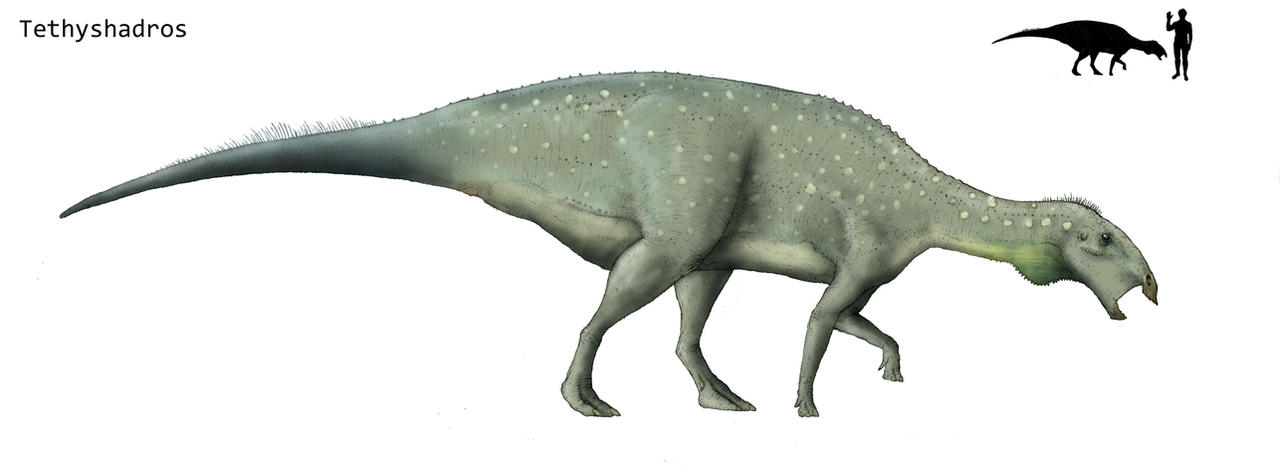Post by Infinity Blade on Apr 3, 2015 23:48:28 GMT 5
Tethyshadros insularis

© @ Hyrotrioskjan
Temporal range: Late Cretaceous
Scientific classification:
Domain: Eukaryota
(unranked): Unikonta
(unranked): Opisthokonta
(unranked): Holozoa
(unranked): Filozoa
Kingdom: Animalia
Subkingdom: Eumetazoa
(unranked): Bilateria
Superphylum: Deuterostomia
Phylum: Chordata
Infraphylum: Gnathostomata
Clade: Eugnathostomata
Clade: Teleostomi
Superclass: Tetrapoda
Clade: Reptiliomorpha
Clade: Amniota
Class: Reptilia or Clade: Sauropsida
Clade: Eureptilia
Clade: Romeriida
Clade: Diapsida
Clade: Neodiapsida
Clade: Archelosauria
Clade: Archosauromorpha
Clade: Archosauriformes
Clade: Crurotarsi
Clade: Archosauria
Clade: Avemetatarsalia
Clade: Ornithodira
Clade: Dinosauromorpha
Clade: Dinosauriformes
Clade: Dinosauria
Order: †Ornithischia
Clade: †Genasauria
Clade: †Neornithischia
Clade: †Cerapoda
Clade: †Ornithopoda
Suborder: †Iguanodontia
Clade: †Dyromorpha
Clade: †Ankylopollexia
Superfamily: †Hadrosauroidea
Genus: †Tethyshadros
Species: †T. insularis
Tethyshadros insularis is a species of hadrosauroid that lived in Italy. The animal lived on an island in the Tethys Ocean and it was concluded that the holotype specimen was an insular dwarf given its comparatively small body size (~3.6 meters long in total body length). The skull of Tethyshadros was notably long and large and the infratemporal fenestrae were especially large. The rhamphotheca's serrated edges pointed forward and looked like spikes pointing forward from the premaxilla. Said structure's function is not clear. Manual digits l and V had completely disappeared, giving Tethyshadros only three digits on each manus. Likewise, the rest of the three metacarpals were notably "long, slender, and closely appressed". This was interpreted as a cursorial adaptation. Furthermore, the tibia is longer than the femur, another cursorial adaptation. The tail also suggested cursoriality in Tethyshadros; "a long proximal portion lacks chevrons, the vertebral centra themselves are rather long, and the distal caudals are rod-like. The most proximal chevrons are long and rod-like, the more distal ones have expanded ventral ends, and those near the tail-tip are shaped like an inverted ‘T’. These vertebral and chevron features imply that the caudofemoral muscles – the main retractors of the hindlimb – were particularly big and powerful in Tethyshadros, and again here is an indication that this animal was a specialised cursor".[1][2]

A picture of the holotype specimen of T. insularis

A restoration of Tethyshadros' head. © @ Davide Bonadonna
References:
[1] "Tethyshadros insularis, a new hadrosauroid dinosaur (Ornithischia) from the Upper Cretaceous of Italy" (Dalla Vecchia, 2009).
[2] scienceblogs.com/tetrapodzoology/2009/12/22/dwarf-island-dwelling-hadrosaur-tethyshadros/

© @ Hyrotrioskjan
Temporal range: Late Cretaceous
Scientific classification:
Domain: Eukaryota
(unranked): Unikonta
(unranked): Opisthokonta
(unranked): Holozoa
(unranked): Filozoa
Kingdom: Animalia
Subkingdom: Eumetazoa
(unranked): Bilateria
Superphylum: Deuterostomia
Phylum: Chordata
Infraphylum: Gnathostomata
Clade: Eugnathostomata
Clade: Teleostomi
Superclass: Tetrapoda
Clade: Reptiliomorpha
Clade: Amniota
Class: Reptilia or Clade: Sauropsida
Clade: Eureptilia
Clade: Romeriida
Clade: Diapsida
Clade: Neodiapsida
Clade: Archelosauria
Clade: Archosauromorpha
Clade: Archosauriformes
Clade: Crurotarsi
Clade: Archosauria
Clade: Avemetatarsalia
Clade: Ornithodira
Clade: Dinosauromorpha
Clade: Dinosauriformes
Clade: Dinosauria
Order: †Ornithischia
Clade: †Genasauria
Clade: †Neornithischia
Clade: †Cerapoda
Clade: †Ornithopoda
Suborder: †Iguanodontia
Clade: †Dyromorpha
Clade: †Ankylopollexia
Superfamily: †Hadrosauroidea
Genus: †Tethyshadros
Species: †T. insularis
Tethyshadros insularis is a species of hadrosauroid that lived in Italy. The animal lived on an island in the Tethys Ocean and it was concluded that the holotype specimen was an insular dwarf given its comparatively small body size (~3.6 meters long in total body length). The skull of Tethyshadros was notably long and large and the infratemporal fenestrae were especially large. The rhamphotheca's serrated edges pointed forward and looked like spikes pointing forward from the premaxilla. Said structure's function is not clear. Manual digits l and V had completely disappeared, giving Tethyshadros only three digits on each manus. Likewise, the rest of the three metacarpals were notably "long, slender, and closely appressed". This was interpreted as a cursorial adaptation. Furthermore, the tibia is longer than the femur, another cursorial adaptation. The tail also suggested cursoriality in Tethyshadros; "a long proximal portion lacks chevrons, the vertebral centra themselves are rather long, and the distal caudals are rod-like. The most proximal chevrons are long and rod-like, the more distal ones have expanded ventral ends, and those near the tail-tip are shaped like an inverted ‘T’. These vertebral and chevron features imply that the caudofemoral muscles – the main retractors of the hindlimb – were particularly big and powerful in Tethyshadros, and again here is an indication that this animal was a specialised cursor".[1][2]

A picture of the holotype specimen of T. insularis

A restoration of Tethyshadros' head. © @ Davide Bonadonna
References:
[1] "Tethyshadros insularis, a new hadrosauroid dinosaur (Ornithischia) from the Upper Cretaceous of Italy" (Dalla Vecchia, 2009).
[2] scienceblogs.com/tetrapodzoology/2009/12/22/dwarf-island-dwelling-hadrosaur-tethyshadros/



